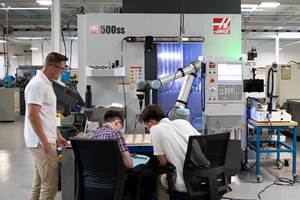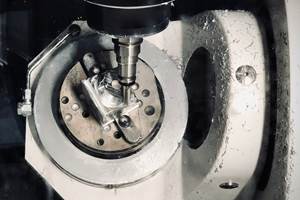High-Production Multitasking Becoming More Flexible
Platforms such as multi-spindles and rotary transfer machines remain well-suited for high-volume production but are now more accommodating to smaller batch sizes.
Share






Historically, single- and multi-spindle automatics and rotary transfer machines have been tooled to run specific jobs for extended periods of time. These might drop complete parts such as automotive, hydraulic or pneumatic fittings every few seconds. That said, builders of these machines are building flexibility into their designs to enable faster changeovers to new jobs. While still well-suited for high-volume production, new models can more readily accommodate smaller batch sizes.
Multi-spindles feature numerous machining stations having independent spindles through which barstock is fed into the workzone. The spindles are mounted in a drum that indexes them from one station to the next. Different operations are performed at each station until the part is completed. “Double drops” are also possible when only half of a machine’s stations are required to complete a part. In this case, the machine is essentially two in one, producing either two identical parts or two different parts in the same cycle. The animation below from Index demonstrates how an eight-spindle machine functions.
Index now offers its new MS32-6 multi-spindle lathe, which is said to open the option of multi-spindle technology to a broader range of shops. This machine includes the company’s new tool slide platform that uses a W-serration interface to enable fast changeovers with precision locating. Additionally, a new quick-clamping system is said to make it easy to bring in tools that have been setup offline. Index says the combination of these features can cut setup times by more than 90%, enabling shops to achieve the high productivity multi-spindles are known for with versatility to run smaller lot sizes.
Multi-station rotary transfer machines function similarly, moving parts installed on an indexing vertical or horizontal table from machining station to station as shown in the following video from Hydromat.
Hydromat’s Eclipse is a redesign of the company’s rotary transfer platform using all electric servo spindles and slides. No hydraulics are used for tool spindle motion. The machine’s ductile iron casting is designed to use semi-permanent tool spindles each having three-axis capability. This is said to eliminate the need to change tool spindle sizes for different cutting processes or adding a three-axis flanges for that capability.
Builders such as Gnutti are similarly designing their machines with flexibility in mind. For example, the company’s Piccola machine processes coil stock in diameters as large as 13 mm. Machining from coil eliminates the need to change to new barstock sizes and enables shops to realize high material usage as there is no barstock remnant. But, in addition, the Piccola machine has a new multiple-station, tool change system that can accommodate as many as six tools. This offers versatility to run different jobs or have redundant tooling for long-running jobs.
Another model, the Double Front, produces parts from barstock. It features tool stations on either side of a vertical turret with part transfer from one side to the other. Having two independent chucks for each station is said to make it possible to better split the operations without having limits on backworking operations. Reliance Worldwide Corporation has three such machine in its Cullman, Alabama facility as part of machining and assembly cells producing its popular SharkBite push-to-connect plumbing fittings.
Similarly, with its MultiX rotary transfer platform, Mikron says it has placed the emphasis on its configurability, scalability and flexibility. These machines offer true turning capabilities and the ability to have up to three tools in the cut in one station (a machine can have 4-24 stations). All standard machining units are exchangeable and precisely repositionable. Therefore, a machine configured for one job can be re-configured for another job by exchanging machining units. In addition, different toolholders are available and multiple tools can be mounted on each unit. The zero-point workholding concept is what enables repeatable positioning and fast changeovers.
Porta’s PortaCenter concept was also developed to meet the needs of high-mix production as the company says the total volume of parts needed continues to rise, but the lot sizes are shrinking. These standard model machines have three 4-axis machining stations and one load/unload station and offer — in a single unit — an alternative to multiple, conventional 4-axis horizontal machining centers (HMCs). This is said to reduce costs related to fixturing, tooling, labor, floorspace, inspection and utilities while providing fast changeovers to new jobs. In fact, the company says the PortaCenter’s additional A and U axes enable it to machine parts in one setup that a conventional HMC cannot. The standard PortaCenter ISO40 model offers a 10” work envelope, but the company now offers its ISO50 model, which has a 20” work envelope to accommodate larger parts. Setups are made faster with quick-change pallet systems such as is demonstrated below.
Related Content
CNC Machine Shop Honored for Automation, Machine Monitoring
From cobots to machine monitoring, this Top Shop honoree shows that machining technology is about more than the machine tool.
Read MoreHow to Determine the Currently Active Work Offset Number
Determining the currently active work offset number is practical when the program zero point is changing between workpieces in a production run.
Read More4 Commonly Misapplied CNC Features
Misapplication of these important CNC features will result in wasted time, wasted or duplicated effort and/or wasted material.
Read MoreHow to Successfully Adopt Five-Axis Machining
While there are many changes to adopt when moving to five-axis, they all compliment the overall goal of better parts through less operations.
Read MoreRead Next
AMRs Are Moving Into Manufacturing: 4 Considerations for Implementation
AMRs can provide a flexible, easy-to-use automation platform so long as manufacturers choose a suitable task and prepare their facilities.
Read MoreLast Chance! 2025 Top Shops Benchmarking Survey Still Open Through April 30
Don’t miss out! 91ÊÓƵÍøÕ¾ÎÛ's Top Shops Benchmarking Survey is still open — but not for long. This is your last chance to a receive free, customized benchmarking report that includes actionable feedback across several shopfloor and business metrics.
Read MoreMachine Shop MBA
Making Chips and 91ÊÓƵÍøÕ¾ÎÛ are teaming up for a new podcast series called Machine Shop MBA—designed to help manufacturers measure their success against the industry’s best. Through the lens of the Top Shops benchmarking program, the series explores the KPIs that set high-performing shops apart, from machine utilization and first-pass yield to employee engagement and revenue per employee.
Read More






















